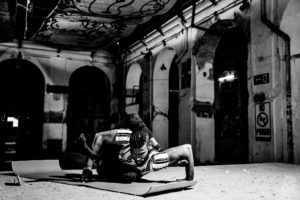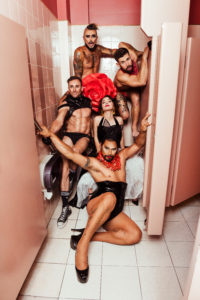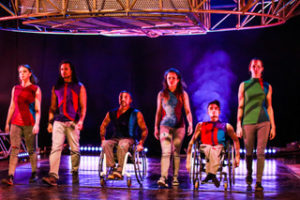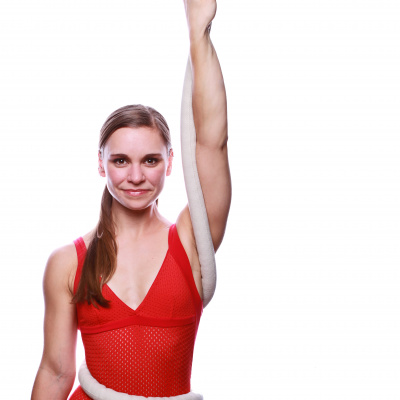Circus Bodies: Meaning Makers and Culture Creators
Circus bodies, as a topic, is enormously complex. The angles from which one could approach the subject are limitless. Circus bodies, as performing bodies, are important producers of culture. They supply us with new knowledge by shifting perceptions and pushing against norms. Taking all of this into consideration, Circus Talk is diving in head first. From February through July 2021, we are producing a series of articles and panel discussions that will focus on circus bodies. The series will explore and invite conversation about aging, fat, gendered, disabled and BIPOC/BAME circus bodies. It will also cover sideshow circus bodies and artists who use their body for extreme circus acts. Each event will be crafted with an acute and sensitive awareness that it is impossible to encapsulate the individual nuances, intersectionalities, stereotypes, and cultural perceptions that any individual or group experiences at any point in a circus career.
I’m sitting at my kitchen counter. It’s late afternoon, and I’m still in my pajamas. I’m sifting through my circus library in search of thoughtful references about circus bodies. It’s proving impossible — circus bodies are everywhere! Authors may not advertise circus bodies as their topic, but rare is a piece of research or writing that does not rely on the corporeal evidence produced by performing circus bodies.
I often hear in conversations that western contemporary circus performances showcase the young, able, athletic, cismale, white body as the norm. The goal of this series is to give space to and lift up a variety of voices (and bodies) that do not identify with these modifiers, and to be an additional platform for active and ongoing conversations. As an able-bodied, white, middle-aged, hetero, ciswoman with access to technology and higher education, I acknowledge my privilege; I also hold positions of power as a performer, teacher, writer and creator. During this series, I will be a researcher and moderator. I take on these roles with gravitas and gratitude for the opportunity to learn from my peers in the global circus community.

It is hard to disentangle any performing art and the humans that perform it. An artist I met recently expressed how using the body in performance is personal and therefore that makes it impossible to separate the person from the message. Performance Studies scholar Peggy Phelan writes about how the performing body is the art it performs. With its “visibility and availability, the performer actually disappears and represents something else — dance, movement, sound, character, ‘art’” (Phelan, 150). Similarly, circus scholar Peta Tait writes that circus bodies “perform cultural ideas: of identity, spectacle, danger, transgression — in sum, of circus.” (Tait 6). Circus bodies are circus.
The Body As Circus
If performing bodies wear the figurative costume of dancer, aerialist, contortionist, or clown, then modifiers to these art forms —male dancer, Black aerialist, Chinese contortionist, or disabled clown — change a viewer’s perceptions of and expectations for that performing body.
The entwining of histories, identity, and cultural perceptions of a circus body is too strong to sever any one link or compartmentalize any singular attribute without doing disservice to the whole circus body.
What perceptions and expectations does the modifier circus add to the noun body? What perceptions and expectations did you apply to yourself when you identified as circus?
Circus bodies are an accumulation of real and conceptual attributes: actual bodies (who is performing), real actions (what are they doing), performed identities (cultural ideas about the actual bodies and/or the characters presented), and perceived meanings (all of these — the bodies, actions and identities — within cultural context). These facets interact like an M.C. Escher drawing: infinite, colliding stairways — one always leading to another which leads back to the first. The entwining of histories, identity, and cultural perceptions of a circus body is too strong to sever any one link or compartmentalize any singular attribute without doing disservice to the whole circus body.
Circus Bodies Teach Us Things
Academics who study performance have a lot to say about bodies. Foucault says, bodies are “the fabric of culture itself” (Tait 7). And “performance offers a way to transmit knowledge by means of the body” (Taylor 36, emphasis original). Most importantly, bodies teach us things. “Beliefs and conventions are passed on through bodily practices, and so are all sorts of assumptions and presuppositions including how we understand bodies“ (Taylor 32, emphasis original). Therefore, performing circus bodies, as culture, have the power to shape culture.

Circus academics constantly write about the prowess of circus performers, their superhuman abilities, their defiance of nature, animal bodies, or the laws of physics. They write about how throughout history, performing circus bodies have been revered, othered, and exoticized, pushed to extreme athletic limits, and how they display real and performative risk. They also write about how performing circus bodies show us the possible by igniting our imaginations. Underneath these comments, these writers are showing how circus bodies are important cultural informants.
By noticing what we see in circus bodies, we can learn about ourselves. For example, certain attributes of a circus body may shine through more brightly than others such as a performer’s gender, race or ability.
Tait writes about female performers in the mid 1900s. Because women were “not expected to do difficult tricks” it made the “athleticism harder to see” (Tait, 150). Claire Hodgson, Co-Founder of Extraordinary Bodies (the UK’s leading professional integrated circus company), says, “Disabled people have historically been shown as vulnerable and fragile. Extraordinary Bodies shows disabled artists doing circus that requires immense strength and skill. It is a rewirement of our culture. The truth is that all bodies are fragile and all bodies are strong.” In a conversation in 2019 about representation in burlesque, NYC performer Ravenessa said, “There are a lot of thoughts about racism, fetish, exoticism. Because there is still an understanding that to be other is to be sexy; to be exotic is to be sexy. The way I see a lot of performers take this on is to become a person of color — to become more exoticized in one way or another. And with the internet nowadays, those things are being challenged immediately.”
Challenging perceptions about gender, ability, racism and exoticism in performing arts is crucial, but performers and spectators can also break ingrained cultural perceptions through performative actions. Tait suggests, “[t]o effect a change in the patterns of social relationships” or to have an exchange that is “potentially disruptive of hierarchical patterning…might require body-to-body (or -bodies) visceral interventions” (Tait, 150). Simply put, we should watch things, people and actions that challenge our norms.
For me, the artist is the most important thing in the world to change minds. — Marco Motta
Circus is a most excellent medium for this. Early drag performers in western traditional circus such as Blondin, pushed boundaries about gender. These days, the cast members of Briefs do the same while also addressing colonialism. Self-described as, “savage gender offenders,” their mashups of gendered clothing, props and personas subvert ideas of masculinity and femininity, and MC Fez Fa’anana, Co-Founder and Artistic Director of the company, is anything but shy to directly address harsh realities of political injustices. Many performers say that in order to combat stereotypes, more representation is needed at all levels of circus productions. In a NYC community discussion titled People of Color in Contemporary Circus, Paris the Hip Hop Juggler explains that increased representation gives audiences a variety of ways to see an art form.“You thought you saw everything you could see about how something can be expressed, but then, no you haven’t… [audiences] started to see a direction you could go if you just hire more people of color. Who is it for? Everybody in terms of just general cultural growth.” Performer Marco Motta said in an interview, “For me, the artist is the most important thing in the world to change minds.”
Powerful Circus Bodies

Through their performative prowess, superhuman abilities and defiance, circus bodies can craft how we perceive ourselves and others. As Fa’anana has said, “Circus has a soft canvas, that’s why it can always be split and rebuilt” (Lavers et. all, 91). This is the beauty of circus as a genre. It is also the beauty and power of circus bodies. Circus bodies have a soft canvas – physical abilities wax and wane with training. Identity has a soft canvas, and circus bodies are in a unique position to split and rebuild cultural perceptions.
Watching performing circus bodies is an incredibly powerful exchange, fraught with exploitative histories, misconceptions and dangerous expectations, but it is also a brilliant conduit for communal laughter, deep empathy, and radiant joy. Circus director Raphaëlle Boitel said that “[circus] is such a good way to be gathered around something that is joyful, beautiful, impressive, but we can talk about very deep subjects, also.” She hopes that her audiences leave a performance feeling, “Hope, joy and [the] hope of ‘we can do better.’ Even if the world is going very wrong, how you learn to do better is to look at each other and be even more awake.” (Boitel).
I hope, as you circus through 2021 (maybe in your pajamas), you recognize and hold the power of your own circus body near and dear in the front of your mind.
Circus Bodies Now
We are living in a moment of history that is consumed with consideration for both our actual, biological body and the perceptions of other bodies. Biology and social identity are intertwined. Our ability to survive a virus which attacks our real, physical body has been determined by the actions of our invented, governing bodies. Individuals’ physical actions have been swayed by social ideologies and constructed concepts regarding physical attributes. Plainly put, we are helping or harming each other’s bodies due to what we’ve been taught to think about each other’s bodies. If we don’t change our perceptions, we will continue to reenact our actions.
Even though a lot of circus is on pause right now — which means a lot of circus bodies are more still, quieter than usual — we can take this opportunity to continue to connect and learn from each other.Through this ongoing discussion, it is my hope that the reader (and myself) will walk away with a more grounded sense of the variety and importance of circus bodies.
To that end, the upcoming articles and discussions in this series will foster education, community, support, empathy, action and when needed, change by highlighting circus bodies as important meaning makers and culture creators.
References Boitel, Raphaëlla. Personal interview. 1 March 2020. Lavers, et. all. Contemporary Circus. Routledge, 2020. Phelan, Peggy. Unmarked: the Politics of Performance. New York, NY. Routledge, 1993. Tait, Peta. Circus Bodies, Cultural identity in aerial performance. Routledge, 2005. Taylor, Diana. Performance. Duke University Press, 2016.
Featured Image: Design by Emily Holt. Photo credits: Joel Deveraux, Marina Levitskaya, James Loudon, Gaby Merz, and Georges Ridel.
Related Content
Circus For Every Body–The Extraordinary Bodies Story So Far,“Go Beyond the Stereotype”: A Thoughtful Discussion Regarding Gender, Binaries, and Contemporary Circus,Men In the Ring — the Rise of the Boy Bands of Circus,Wake Up Call for Inclusion 03 – Institutional Barriers and Individual Biases in the Performing Arts for Women of Color
...
Do you have a story to share? Submit your news story, article or press release.







